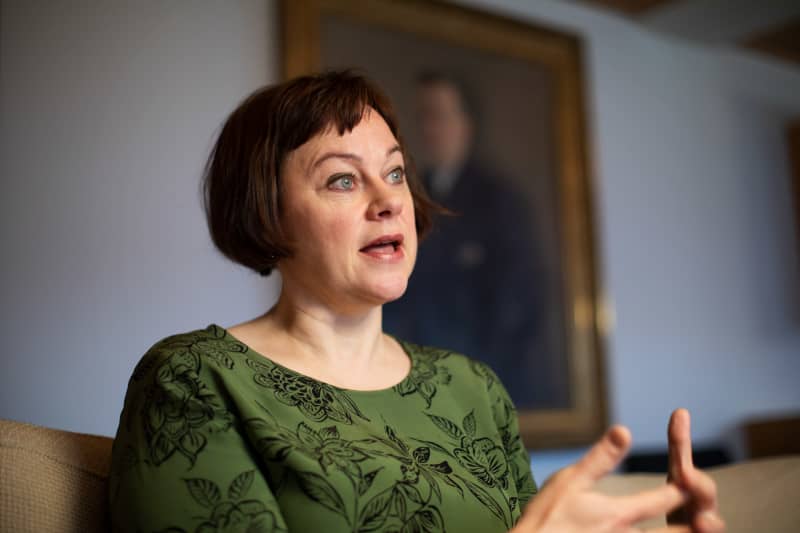Forest companies are thriving on the crest of a wave of good economic times. For example, UPM issued a positive profit warning last week. Paula Lehtomäki, who has taken over as CEO of Metsäteollisuus ry, is pushing for companies’ right to use wood, which the EU is trying to regulate.
According to Lehtomäki, it was a natural move to become the head of the male-dominated forest industry.
– I’m as much from the forest as you can get in this country, right on the edge,” he says, referring to Kuhmo, the region where he was born.
He says that forestry issues have been on the table in various ways since he became an MEP in 1999.
In his opinion, there should be more women in the field. Increasing the attractiveness of the forestry sector is also an increasingly large task for the interest organization during the labor shortage.
The forest industry has 70 members, but the field is dominated by three giants: Metsä Group, Stora Enso and UPM. They are quite strong in pursuing their interests in their own way.
Lobbying on the whole front is needed, especially in Brussels, where the forest industry’s EU influence looks like a constant fight.
There is a record number of regulations targeting forests. There are at least a dozen projects underway, such as increasing biodiversity, the renewable energy directive and a taxonomy assessing the sustainability of an investment target.
Forests back to their 1950s state
Now the industry is focusing its efforts on the restoration regulation presented by the EU Commission.
– It is disproportionate for Finland. The direct costs for Finland have been calculated as the third highest among the member countries. The effects would thus be the most significant for Finland in relation to the member countries, says Lehtomäki.
The costs for Finland would be almost a billion euros, while for example Germany’s share is 150 million euros per year.
It’s about which areas in each country need to be returned to their natural state, for example in the conditions of the 1950s. In Finland, there are especially many such areas in, for example, marshes, inland lakes, forests and fells. The purpose is to preserve habitat types and diversity.
Among other things, according to Finnish WWF, forest companies can participate in the costs of restoration because they have benefited from the forests for years.
In Finland, the views of the forest industry often collide with green and environmental organizations.
\”Unfortunately, in the conversation, we are often quite firmly in our own shoes, and no matter what kind of dialogue is used, it is not very easy to get out of the shoes. But there needs to be a dialogue, says Lehtomäki.
Forest carbon sink decreased
The defense of the forest industry and economy usually boils down to how much wood is allowed to be cut.
According to Lehtomäki, the EU should be made to better understand that the forest industry produces products that can replace fossil raw materials.
– When Europe aims for a fossil-free economy and strengthens the green transition, the use of wood-based raw materials is an essential part of the solution. It’s more part of the solution than part of the problem.
According to the Finnish Natural Resources Agency’s estimate, the maximum annual logging volume that can be maintained is 80.5 million cubic meters in the period until 2025. This year, an estimated 72 million cubic meters of wood will be cut.
– In the domestic sink discussion, we tend to forget that forests are still a sink. The forest grows more than it is used.
Forests are still a carbon sink, but the sink has decreased because tree growth has decreased and logging has increased.
According to Statistics Finland’s preliminary data, last year, for the first time, the land use sector produced more greenhouse gas emissions than it stored them. The land use sector includes land use, land use changes and forestry.
A lot has been counted on carbon sinks when Finland strives to meet its climate goals. Finland’s goal is to be carbon neutral in 2035.
If the help brought by the carbon sink decreases, emissions must be reduced more in e.g. transport, heating and agriculture. If emission reductions cannot be made, emission rights must be purchased.
– How much is to be achieved with emission reductions and how much is compensated with sinks. There is a political solution, where there is a focal point.
Lehtomäki reminds that carbon is bound by the growing forest.
– If we want the sinkholes to develop well even over a long period of time, it requires active forest management measures and also forest resource use measures. The pharynx does not grow when stored.

The forest industry was a powerful organisation
Metsäteollisuus ry’s role narrowed when the organization withdrew from the TES tables. The organization no longer represents companies in collective bargaining, but each company negotiates its own contracts.
Once upon a time, Metsäteollisuus was a powerful organization whose wishes for devaluations, among other things, were heard by the government with a sensitive ear. Patruuni, i.e. the leaders of the forest companies, had direct connections to the state leadership. 90 percent of exports were from the forest industry.
In Lehtomäki’s opinion, the old days should not be longed for.
– From the point of view of the national economy, it is good that one sector does not cover 90 percent. Still, a fifth of Finland’s goods exports are forest industry products.
The demand for paper is fading, but pulp, cardboard and wood products bring good profits to forest companies. The companies build their future on the fact that non-renewable raw materials are increasingly replaced by wood-based materials.
Kostamus was the place to visit
It is six kilometers from Lehtomäki’s childhood home to Vartius border wash.
– There was a border crossing point in Kotikylä, where the construction workers from Kainuu went to the construction site on the Kostamus side every Monday morning and left on Friday. I have earned my first money by collecting bottles in the parking lot of Kostamus construction workers.
The first time Lehtomäki visited the Soviet Union was when he was nine years old, but the visits became more lively when Kuhmo and Kostamus became twin cities.
– For 40 years, I have done cross-border cooperation, but now it is completely over, at least for this part.
In 2014–2015, Lehtomäki served as the chairman of the Finland–Russia club. He describes the current situation in Russia as miserable.
– In my lifetime, there will never be another time like what I have experienced.

A rising star in the centre approved the gas pipeline
The acquisition of the Talvivaara shares by the Lehtomäki family just before the company’s uranium project caused an uproar in 2010. The Financial Supervisory Authority cleared up the insider’s suspicions but gave an acquittal decision.
As environment minister of the old government, Lehtomäki was approving the decision on the Nord Stream I gas pipeline in 2009.
He emphasizes that things look very different in today’s reality than they did back then.
– A careful environmental impact assessment of the pipeline project was also carried out with regard to impacts crossing international borders. The gas pipeline is not in Finnish territorial waters, in which case it was necessary to act according to the principles of international maritime law.
Upon entering his new workplace, Lehtomäki discovered that there is a popular karaoke bar in Pataäs downstairs.
– I didn’t know if I should cry or laugh, somehow I think it’s a hilarious coincidence.
He thinks he can sing in the bar downstairs one day.
How about spaghetti?
– I haven’t tried it in a while. But I have started yoga, it increases mobility.

